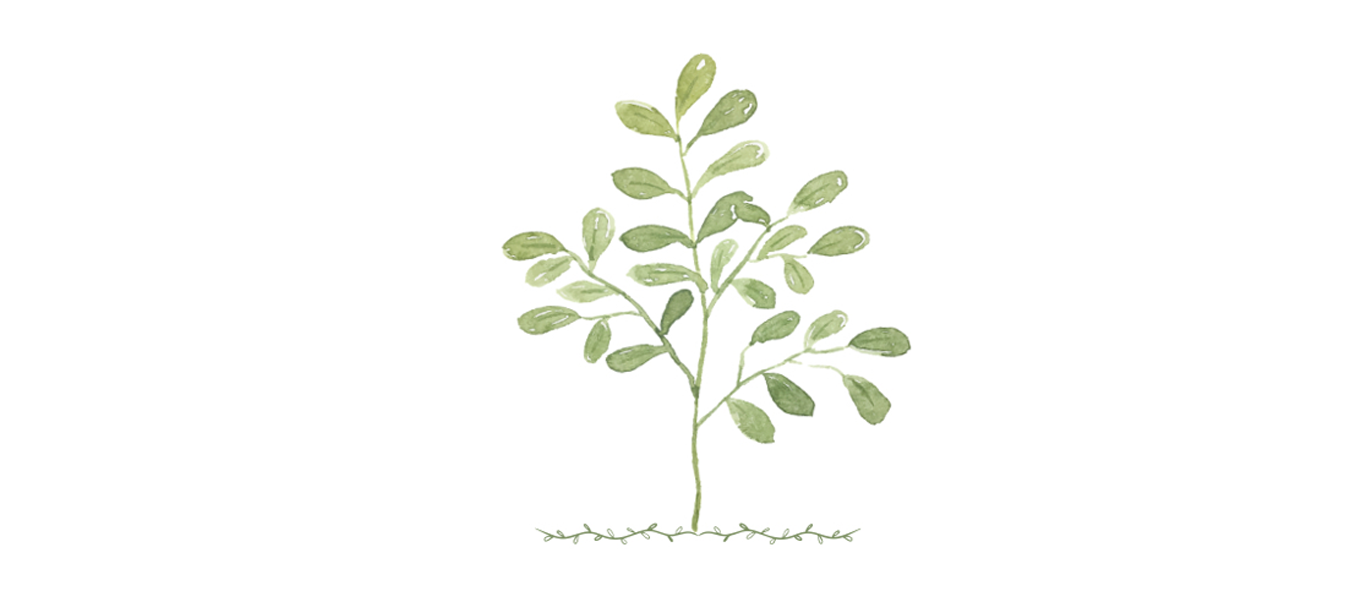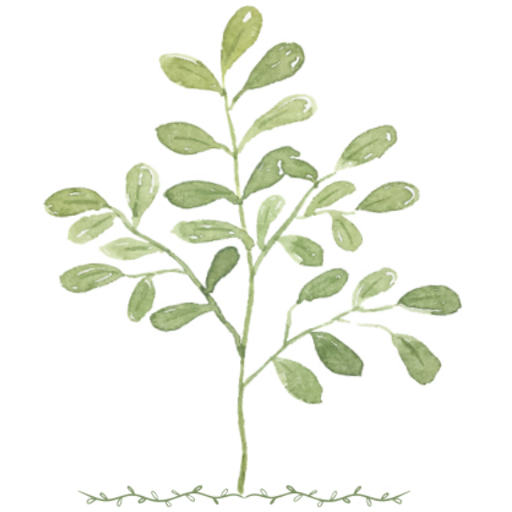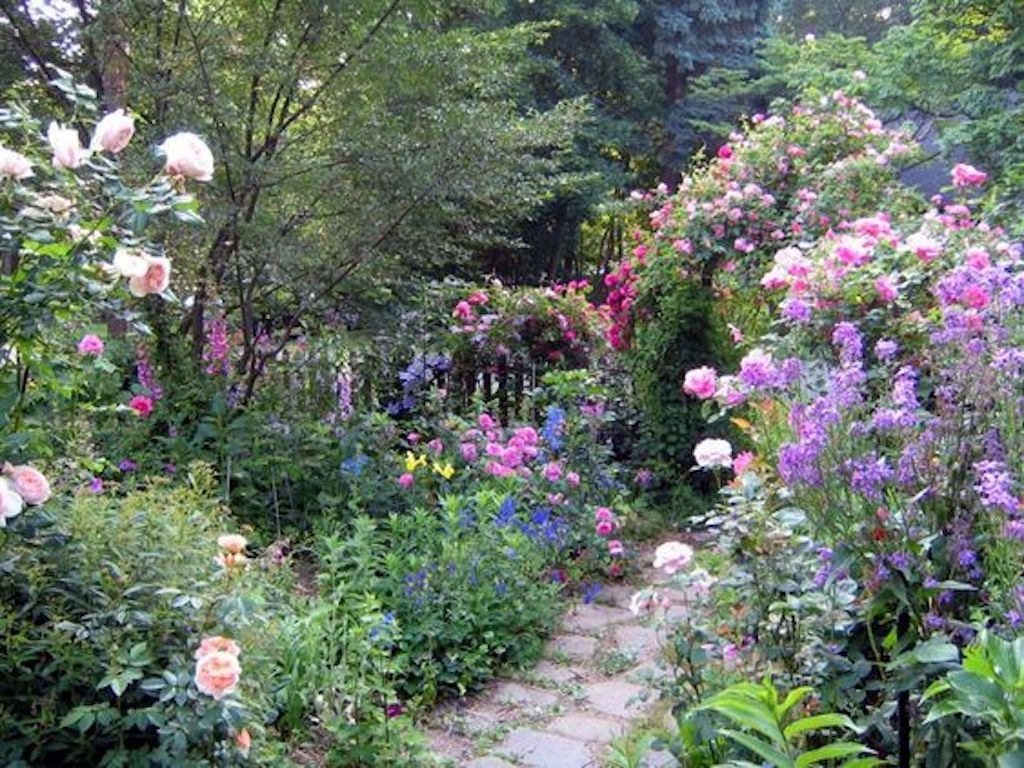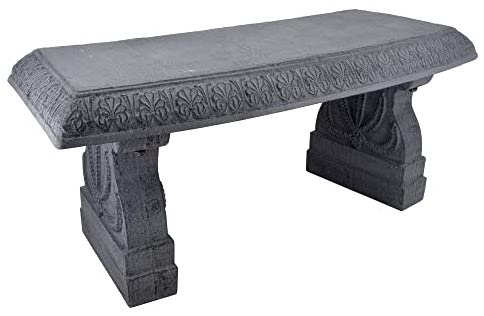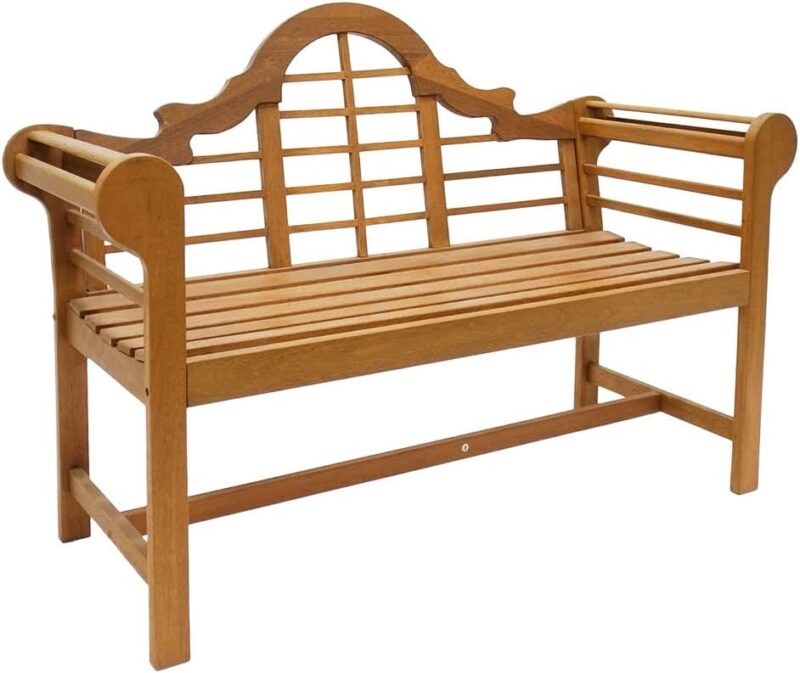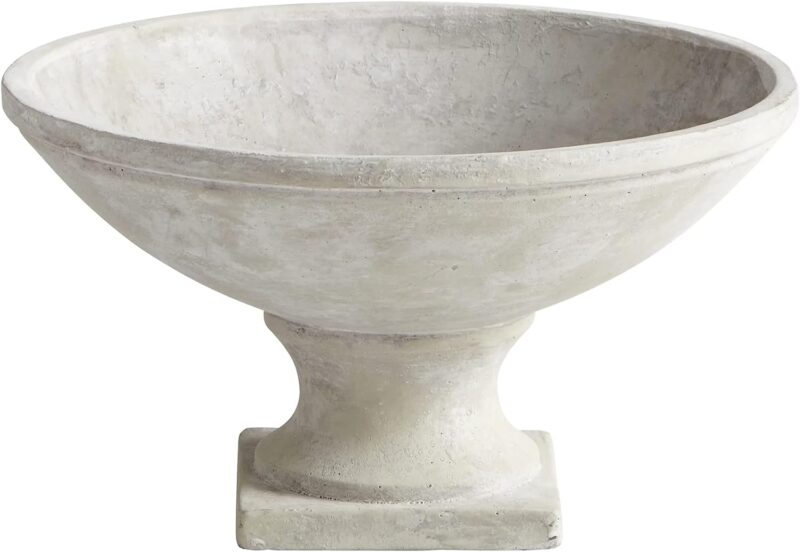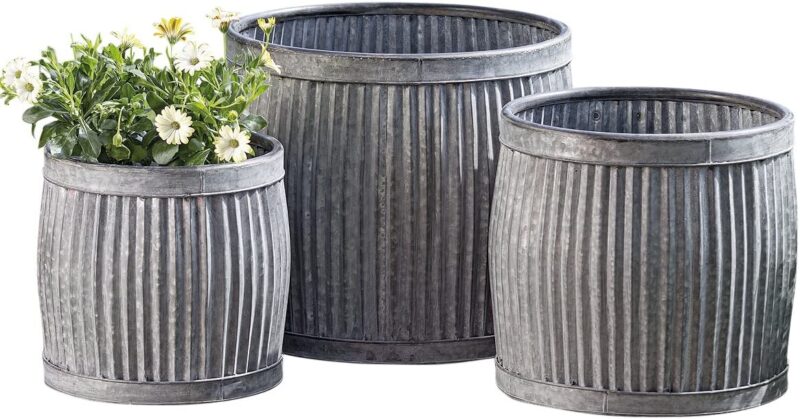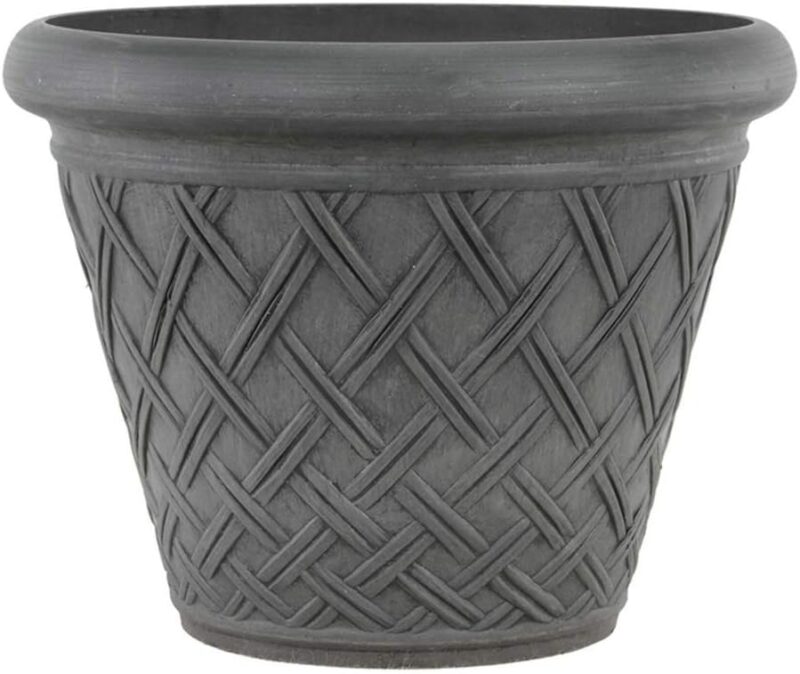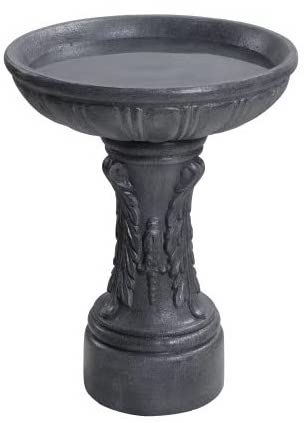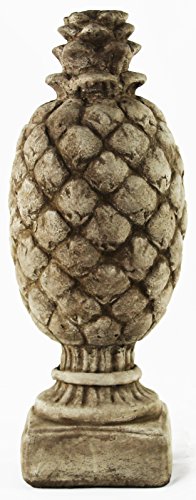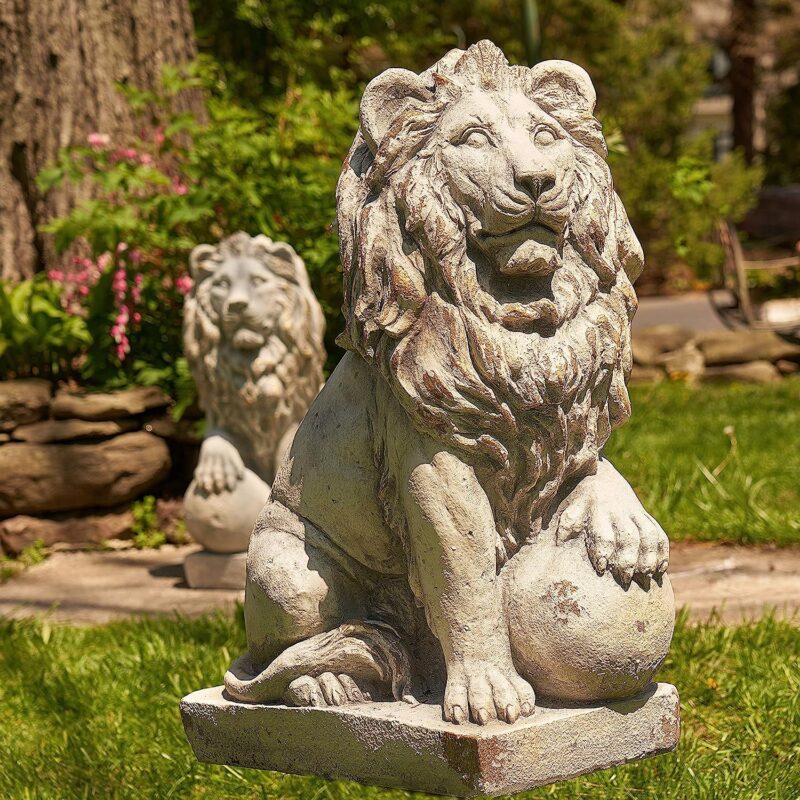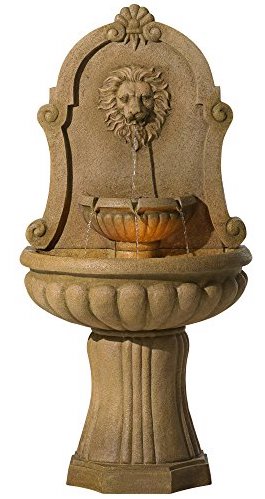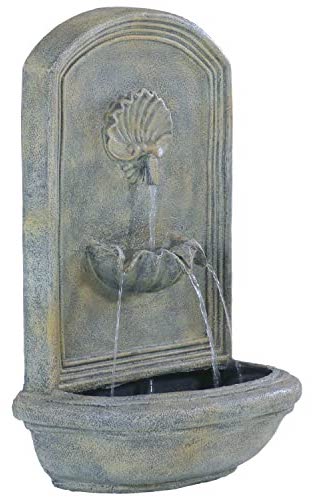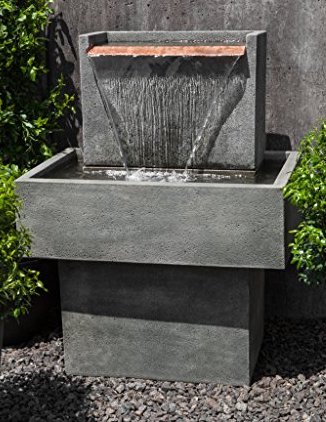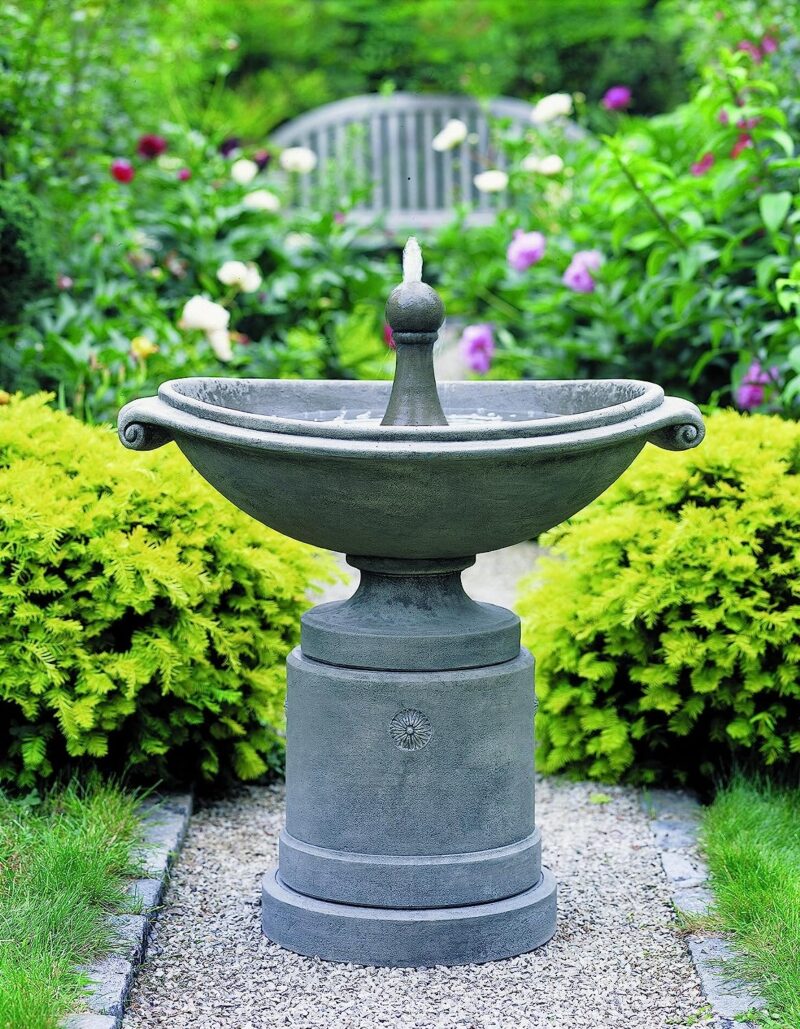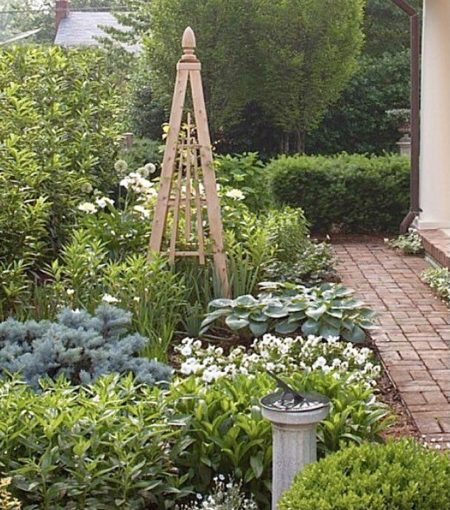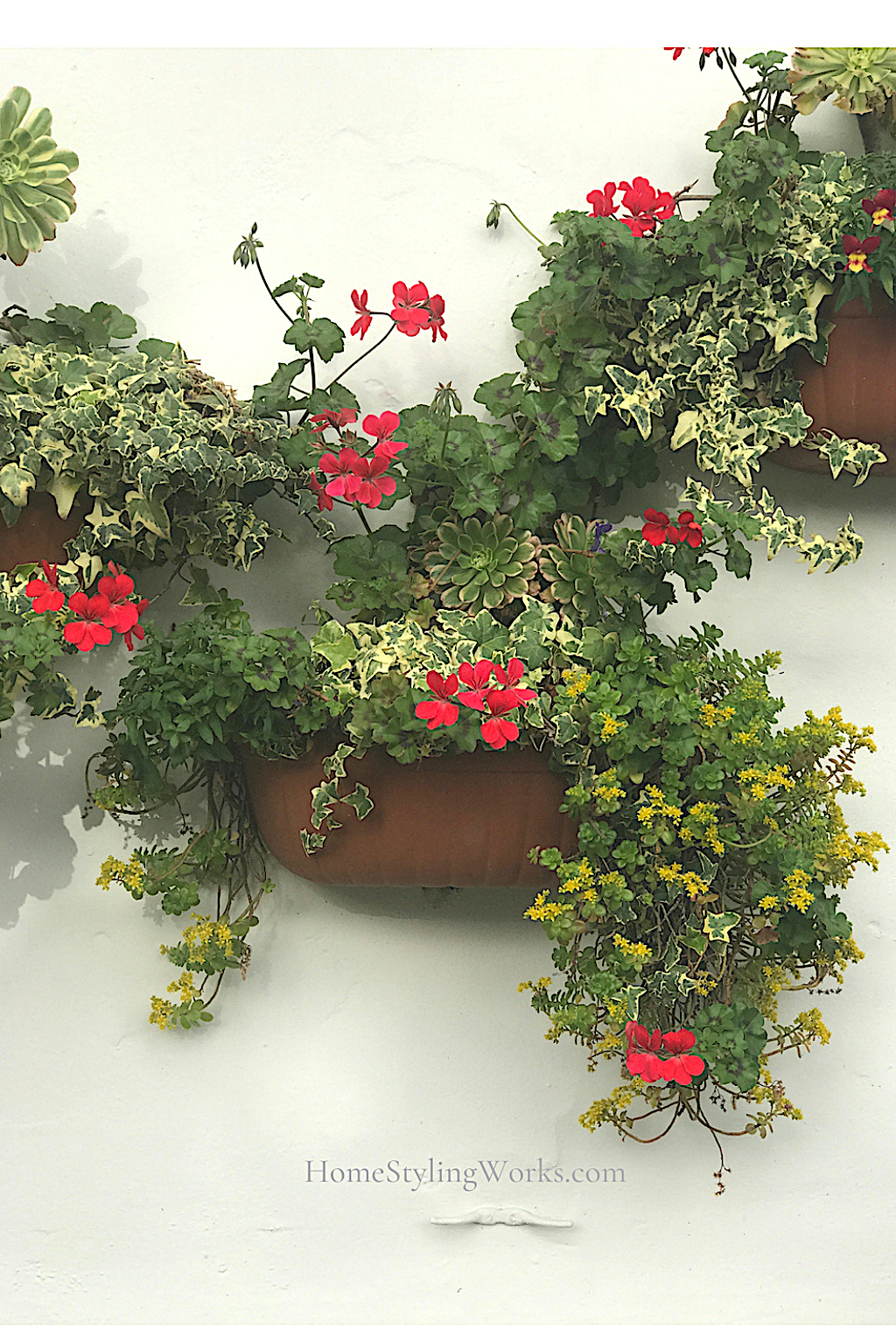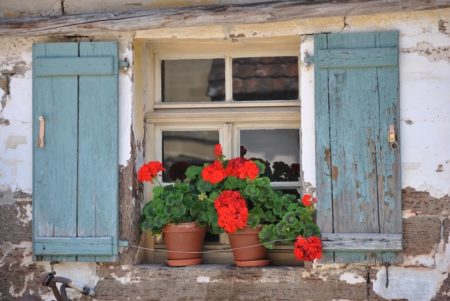Claude Monet once said “My garden is my most beautiful masterpiece”. I totally understand. In the 30+ years I’ve been creating gardens, I consider each one to be a little masterpiece, no matter the size. My gardens in various homes have run the gamut of styles – from cottage plantings to edible gardens to grand English-style perennial gardens. My current garden that I created in Summerlin, Nevada was inspired by gardens in the arid climates of Provence and Tuscany.
While it might seem like a daunting task to create a garden from scratch, it’s a learning process. In today’s post, I’m going to break down my ten elements to consider when creating your own garden.
But before we get to the principles, the first thing you should determine is what kind of garden you want to create. Will it be mostly green, with a mix of textures like the gardens of La Louve in Provence (below left)? Or do you prefer a mix of greenery and a few softly colored flowers (below center)? Or a profusion of continuous color with mostly flowers (below right)? There’s no right or wrong answer – just a matter of personal preference.
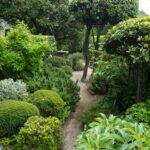
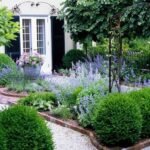

If you’re not sure of what kind of garden you like, I suggest digging into some of my favorite gardening books for inspiration.
Once you determine the STYLE of garden you would like for your space, you can apply the following principles to create, as Claude Monet said, your own masterpiece.
1. CHOOSE PLANTS SUITABLE FOR YOUR ZONE
Put simply, it goes like this: Don’t fall in love with any plant that won’t be successful in your gardening zone. (Don’t know your zone? Find it here.)
In my desert climate Zone 9b, I can’t grow peonies or lilacs – and I can just forget about ever planting water-guzzling hydrangeas. But instead of focusing on what I CAN’T have, I’ve grown to appreciate the fact that I can grow olive trees, artichokes, succulents and fragrant lavender all year long.
Resist the temptation to force a plant to survive out of its natural habitat. As much as I love Japanese maples, I would be doing a disservice to such a lovely (and expensive) tree to plant it in a climate where water and heat are an issue.
My best tip is to check out your local nursery and see what perennials, shrubs and trees they sell, and bear in mind that nurseries only sell what grows in that particular region.
2. INCORPORATE EDIBLE PLANTS & FLOWERS
There’s no gardening law that says you have to dedicate edible plants to their own space. I like to incorporate perennial herbs and even green vegetables like Black Tuscan kale and eggplant into my perennial garden designs.
When adding edible plants and flowers into your garden plan, keep an eye out for interesting textures and variegated foliage. I’ve compiled a list below of some of my favorite edible plants and flowers that are suitable to almost all gardening zones (note that the basil and eggplant are annuals and need to be planted every year).
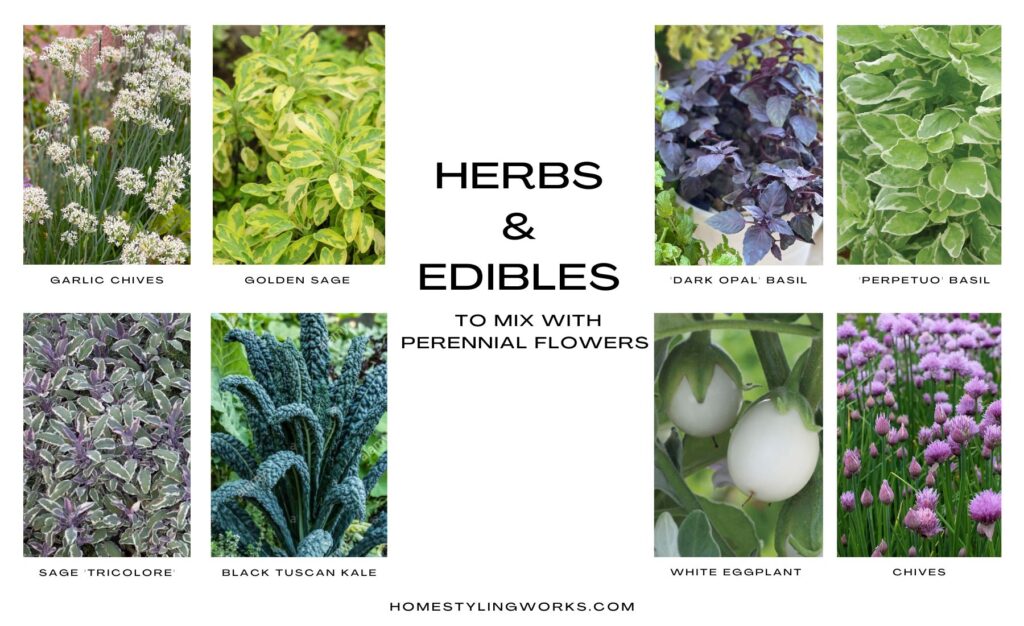
3. COLOR & CONTRAST
A sea of all one color note does not make an interesting garden. You want to aim for color and contrast – so if you have a bright or bold color, it should be offset with a contrasting element. Think of it as a formula: Colorful next to Textural. Bold next to Quiet. Rough next to Soft. Below are a few examples from my own garden.
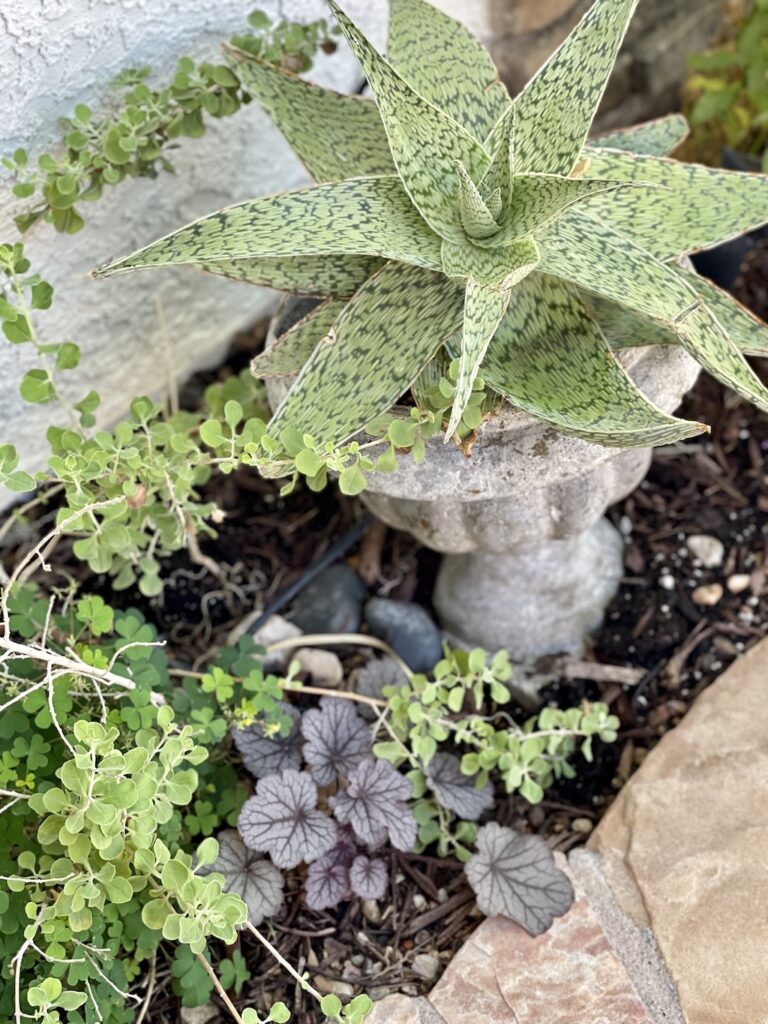

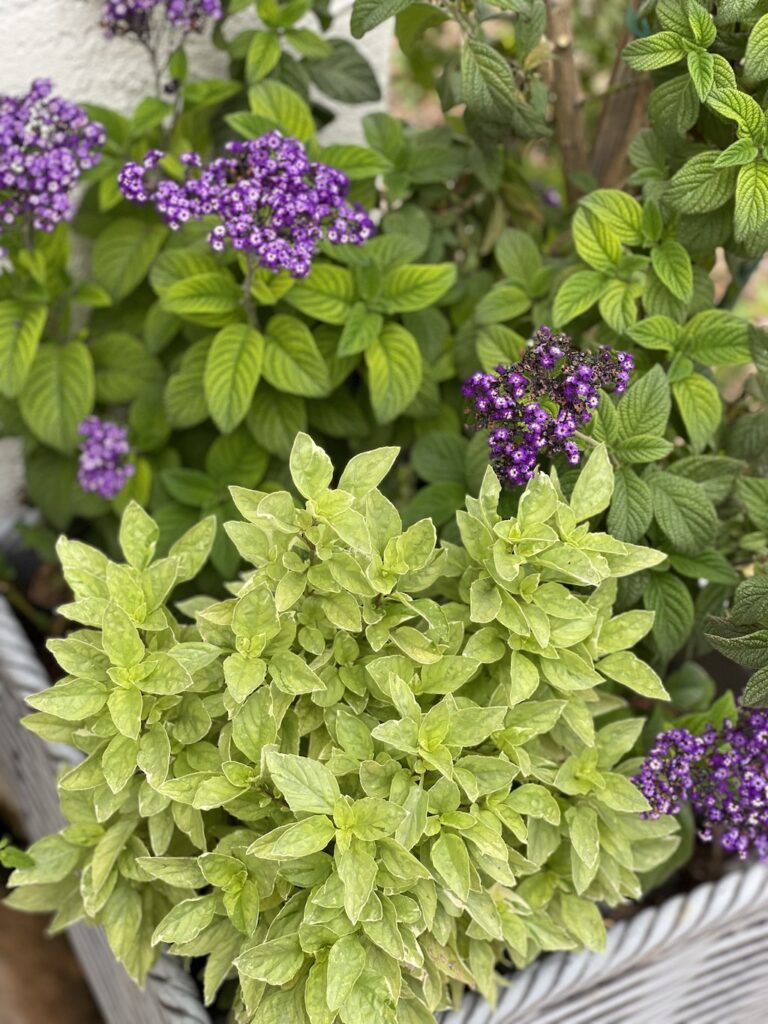
For contrast, I like to add dark garden plants that complement light green or variegated foliage (more on “taking your garden to the dark side” in this post). Conversely, light grey or silvery-hued plants make a lovely counterpoint to dark green foliage and purple flowers (more on “fifty shades of gray” in the garden in this post).
5. GARDEN ORNAMENTS (OR GARDEN “ARCHITECTURE”)
Every garden needs a focal point or a place to rest one’s eye, and I like to achieve that by incorporating interesting garden ornaments into my garden designs. Restraint is the key here. It’s better to have one special garden ornament than a bunch of smaller items scattered about.
In the photo below left, my client fell in love with this statuesque lion ornament, and I gave it pride of place in the entry garden I designed, surrounded by softly flowering nepeta (catmint) at its feet. Other ideas for garden ornaments are a bold armillary perched on a pedestal, an antique olive jar, a sundial, cement pineapple or fruit basket, and even a modern sculpture or antique English chimney pot. I’ve linked to my favorite garden ornaments at the bottom of the post, available to purchase online.
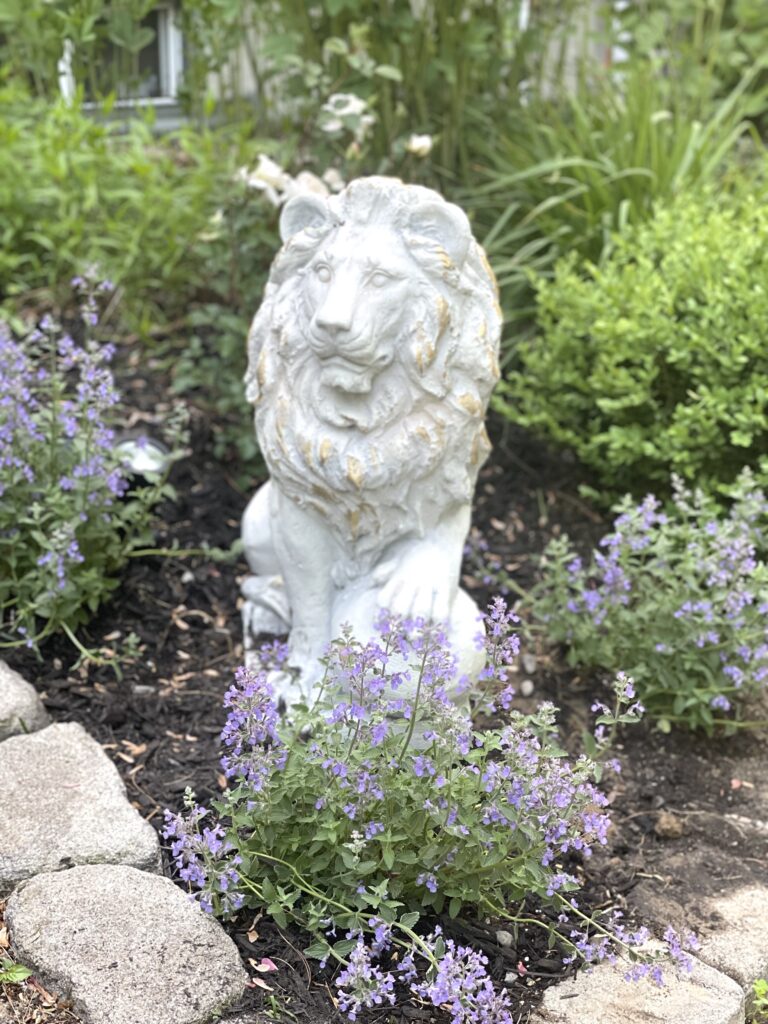
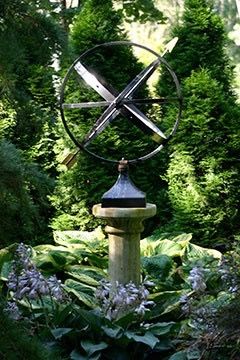
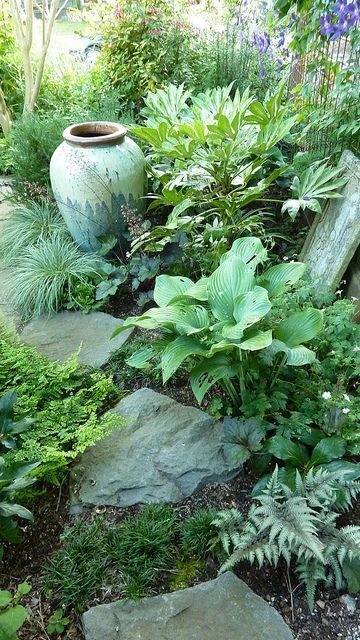
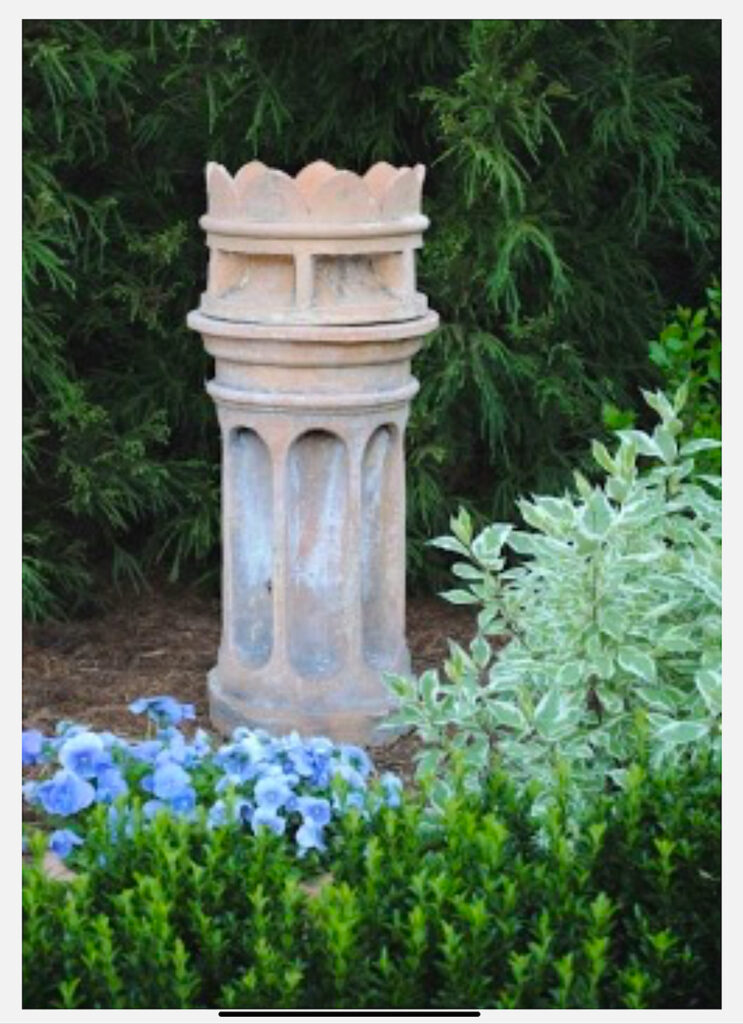
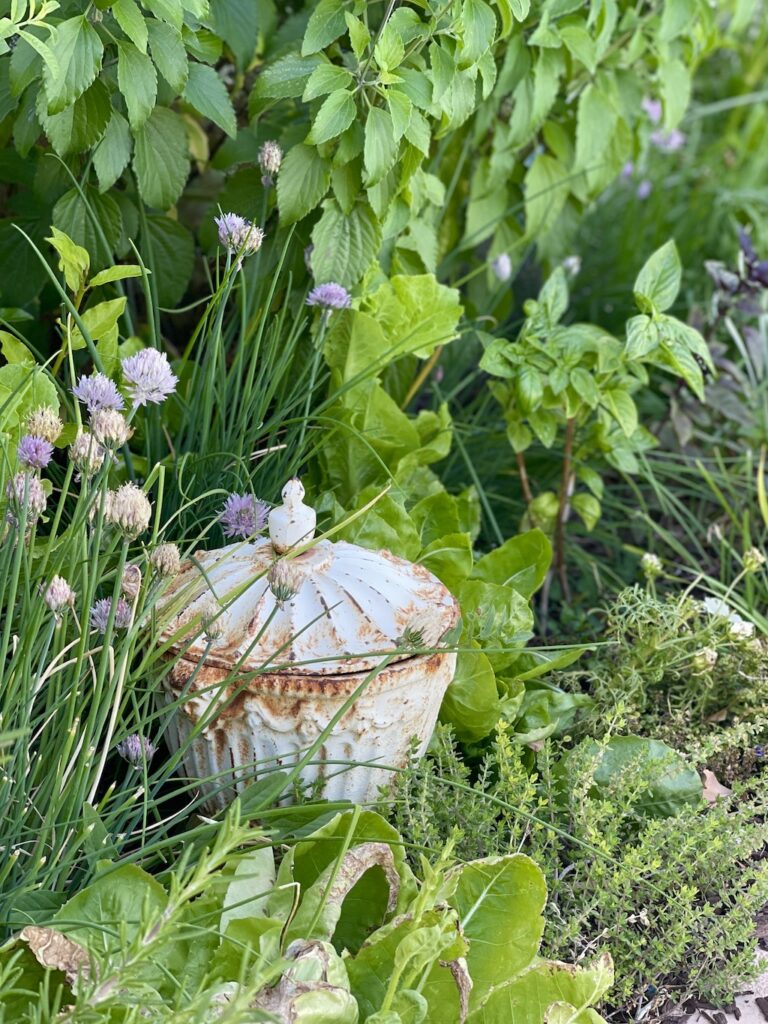
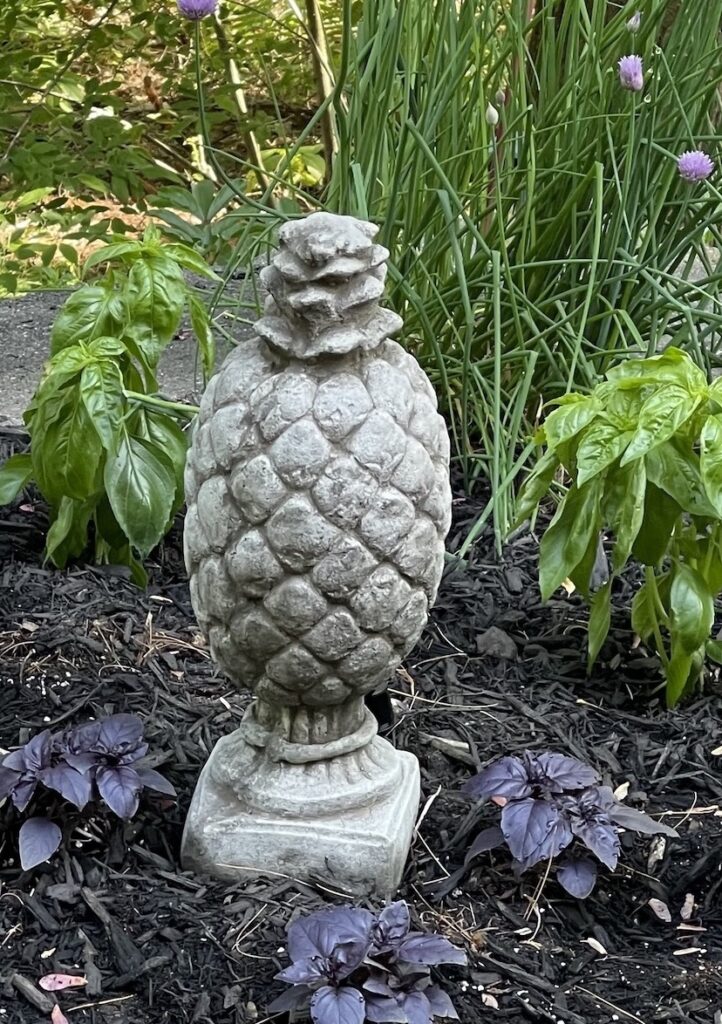
6. ATTRACT POLLINATORS

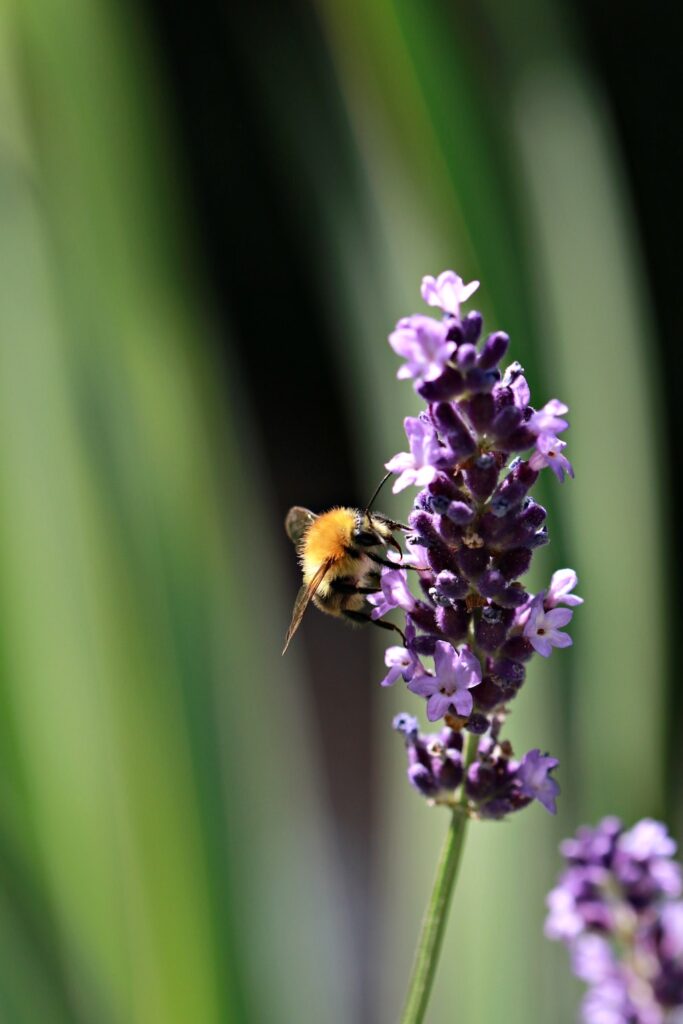

What’s a pollinator? Quite simply, it’s the birds and the bees (and the butterflies, too!) You can create a garden eco-system by adding native pollen- and nectar-producing plants to attract hummingbirds, bees and other essential pollinators.
Some favorite annual flowers that attract pollinators are pentas, cosmos, salvia, snapdragons and zinnia. Perennials include bee balm, lavender, alliums, coneflower, yarrow, asters and sedum. Butterflies in particular love lilac, phlox, mint and pansies.
While we’re on the subject of hummingbirds, I’d like to add that I prefer to give them the “real stuff” (flowers) – there’s no need to spend money on a dedicated hummingbird feeder when you can have Mother Nature do the work for you. I have a family of hummingbirds that visit my garden daily to feast on the flowering lavender, jasmine and salvia that I’ve grown specifically to attract them. Here’s more information about the do’s and don’ts of using a hummingbird feeder.
And don’t forget to give them a water source – a birdbath or fountain is most welcome by hummingbirds and bees (see #10 below).
You can read more about why pollinators are important to the garden here.
7. A PLACE TO PERCH
Every garden deserves to be admired while sitting, so a place to perch should be included in your garden plans, if space allows.
Benches come in a variety of styles – from classic teak Lutyens style to a backless bench that can be tucked in front of a hedge.
I recently designed a Woodland Zen Garden for a client in upstate New York, and it was so peaceful and serene, we decided to add a bench across from the garden for her to use as a quiet, meditative spot.
In my herb garden in Saratoga Springs, NY that was photographed for Better Homes & Gardens “Garden Ideas & Outdoor Living” by photographer Andre Baranowski, I incorporated a bench just outside the perimeter of the herb garden (photo below right).
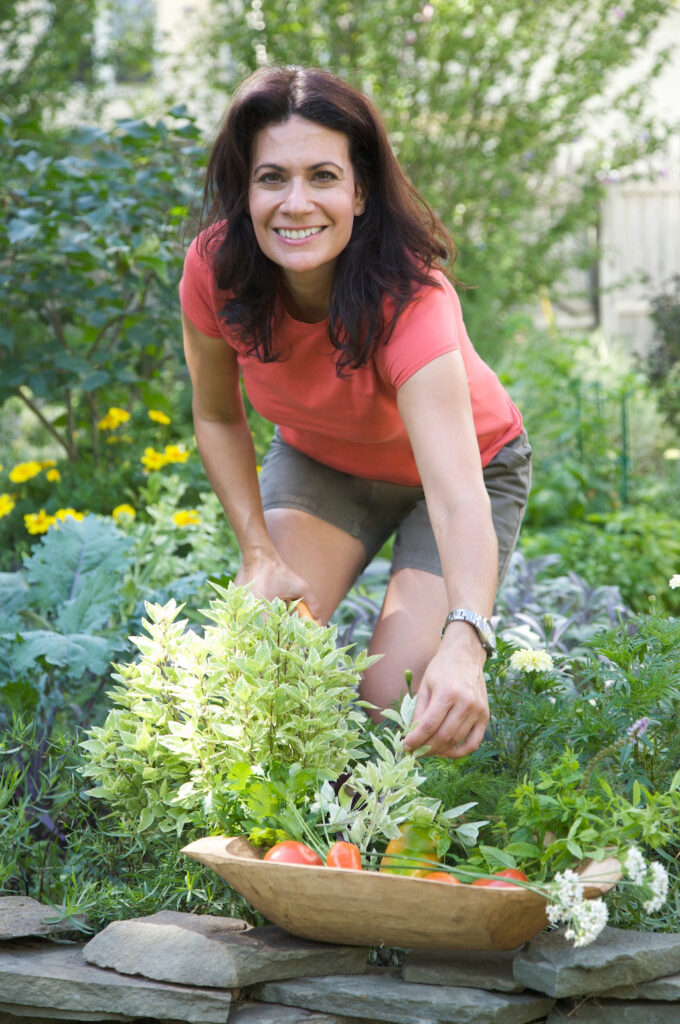
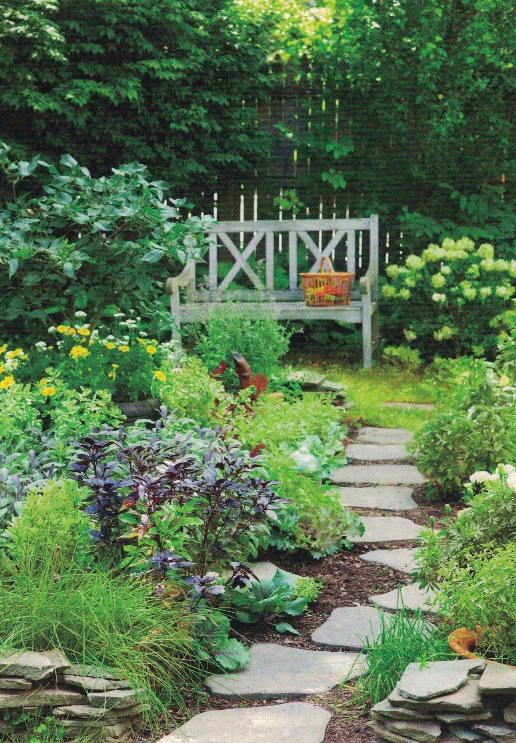
On a recent trip to Paris, I visited the gardens at the Delacroix Museum. Even on a late October day, there was still greenery in the garden. And I fell in love with the gorgeous celadon green benches (and bistro chairs) that were carefully placed around the garden.
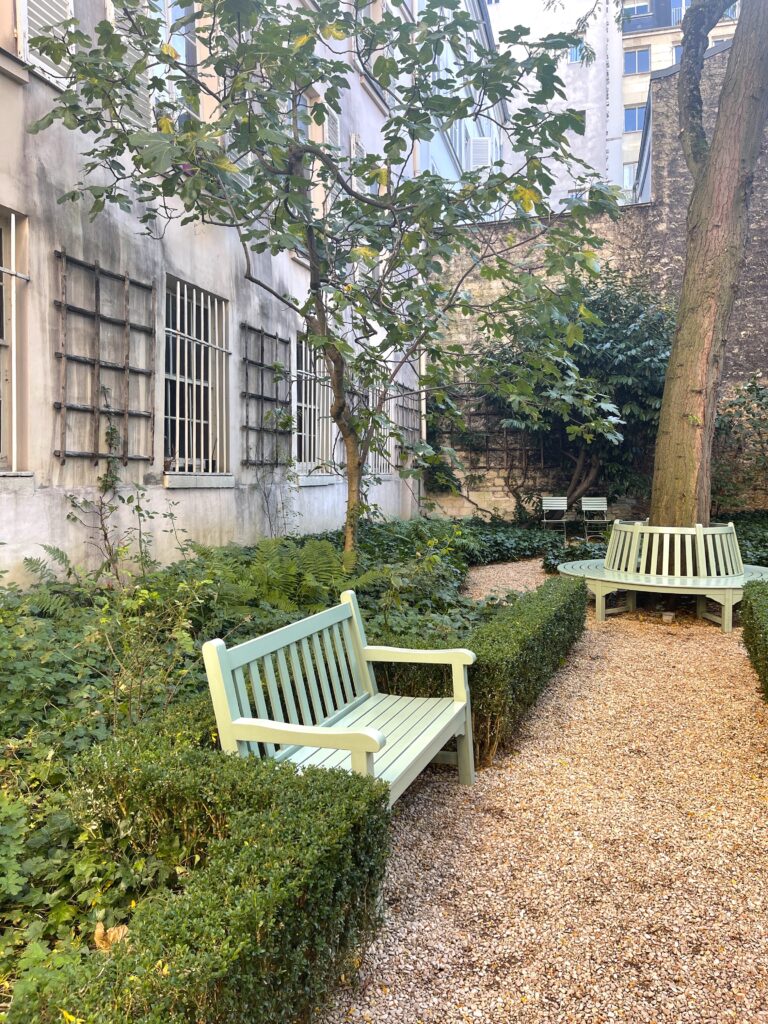
8. VERTICAL ELEMENTS
A garden that is all one one visual plane can be a little boring – that’s why in garden design, a mix of plant textures and heights are added for interest. There’s also another way to add height to a garden, in the form of obelisks, tuteurs and trellises. I wrote a whole post about garden tuteurs (the French word meaning “to train”) and how to incorporate them into your garden.
A trellis attached to a wall with climbing jasmine or clematis adds a green effect while not taking up a lot of garden real estate.
Below are two examples of trellises – below left, I attached a pair of trellises to the wall of my deck in upstate NY, and planted vines in a container (clearly the vines were very happy, as you can barely see the trellis!) Below right, in my current garden, I’m training my tomatoes to grow up a pair of trellises, which is a prettier alternative to tomato cages.
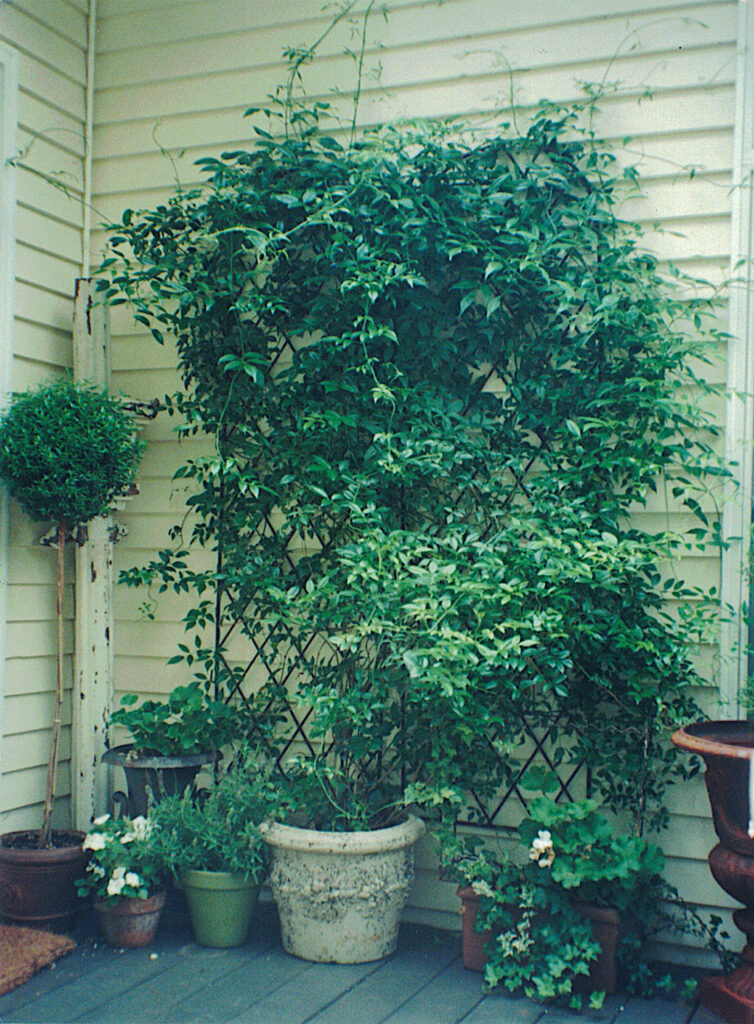
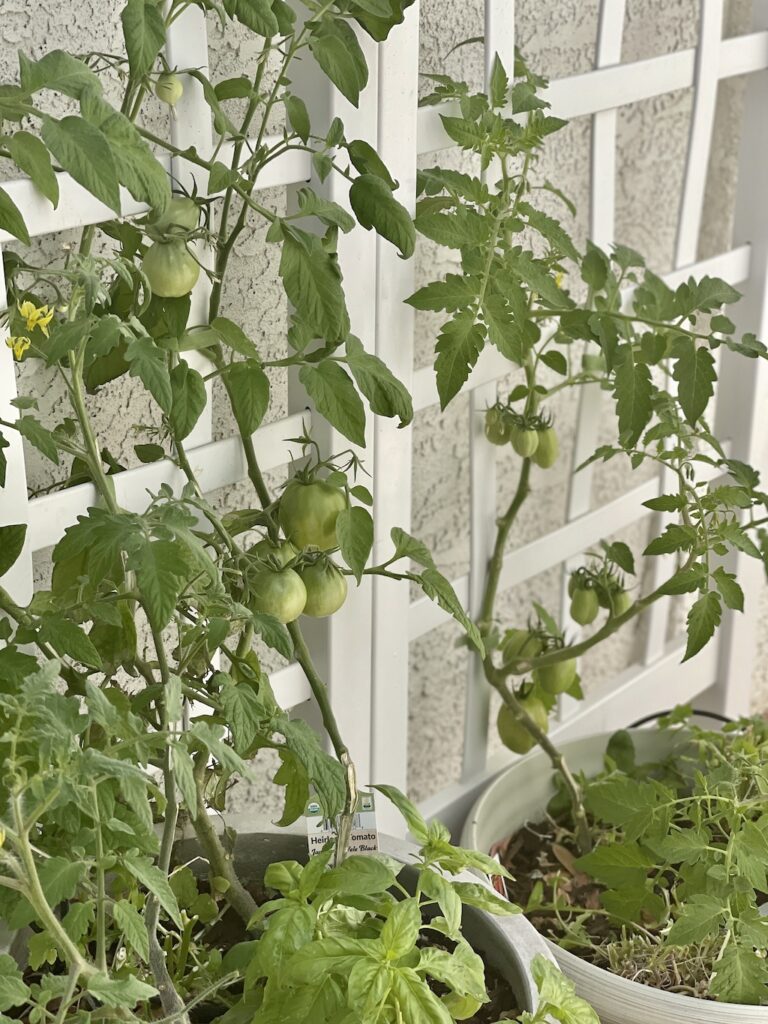
The photo below shows my garden, where I’m growing ‘Iceberg’ roses on an iron tuteur, attaching the branches with velcro garden tape. As the roses grow I’ll prune them so you can see the outline of the tuteur structure.
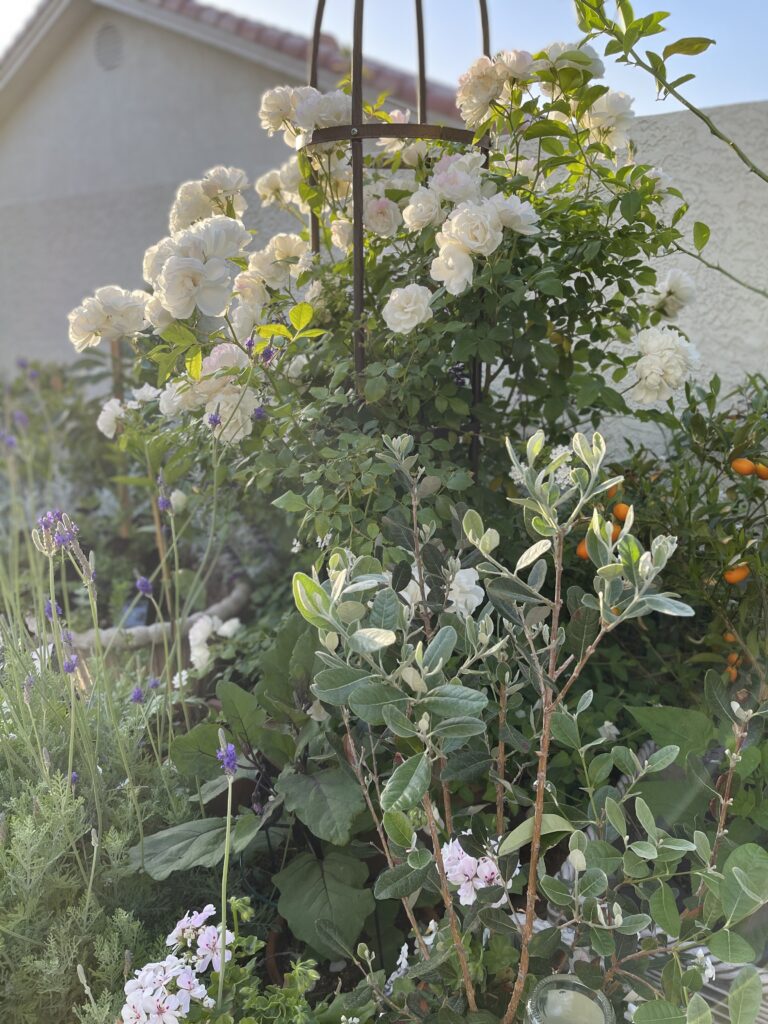
9. LIGHTING
The garden isn’t just for daytime, and lighting is one of the most important elements to making a garden looked finished. Lighting can add drama and mystery to the garden in the evenings and can be used in many forms – from solar uplights behind trees, hanging string lights around a dining pergola to strategically placed outdoor lanterns.
In my terrace garden in Saratoga Springs, NY, which was featured in Better Homes & Gardens “Cottage Style” magazine (photographed by John Bessler), I hung a wrought iron candle chandelier from a large tree, adding a warm glow to the space in the evening.
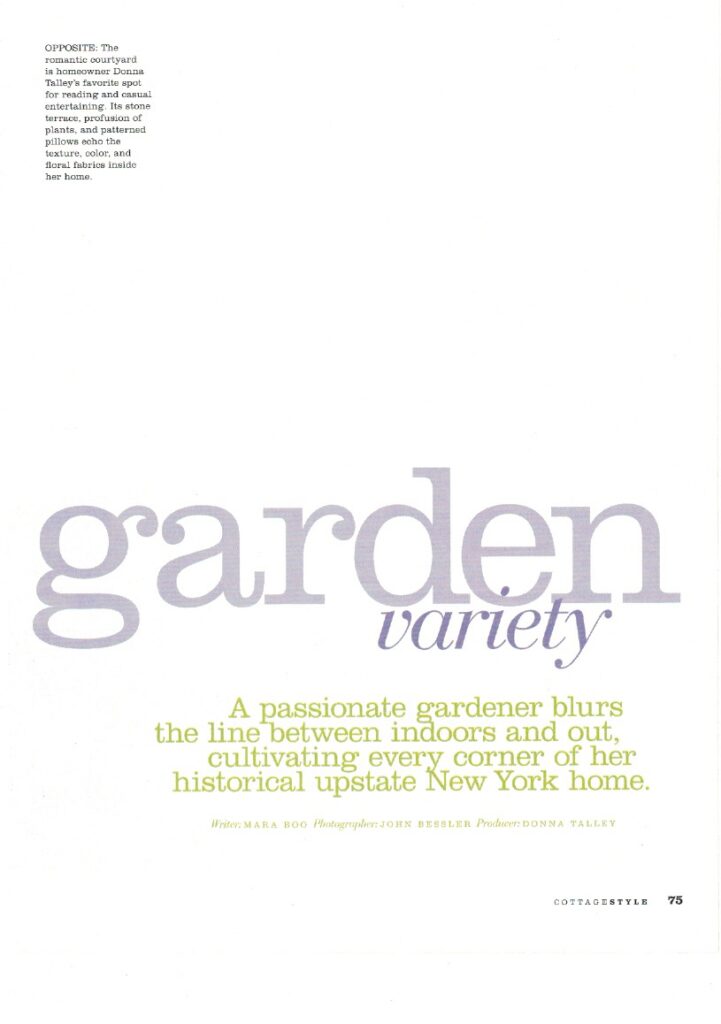
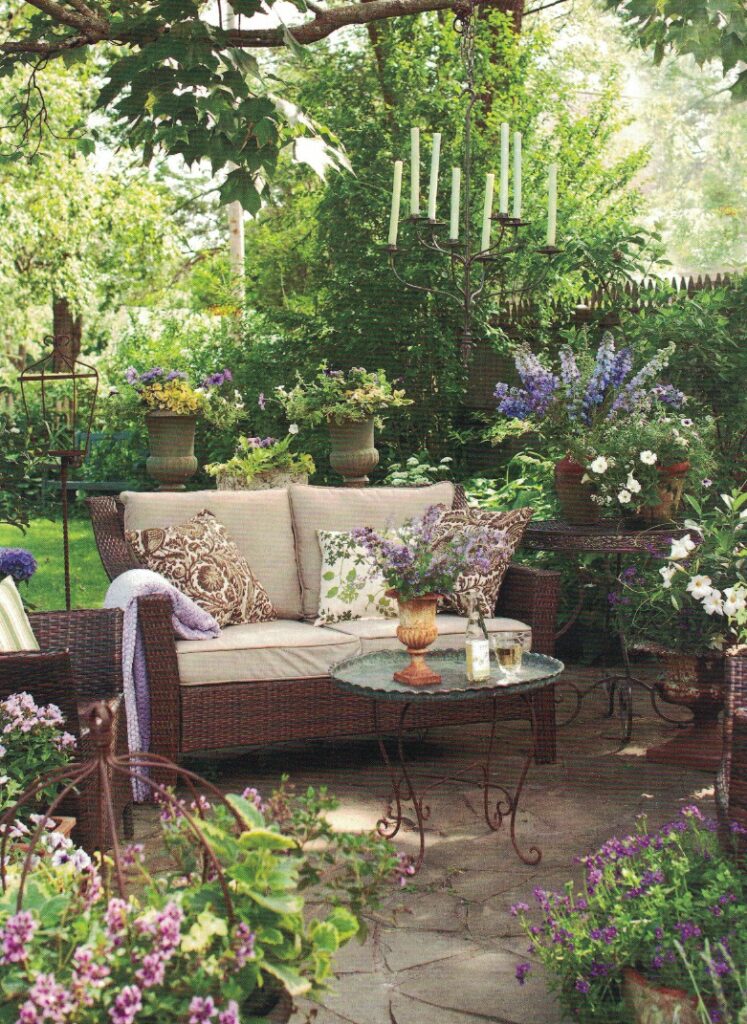
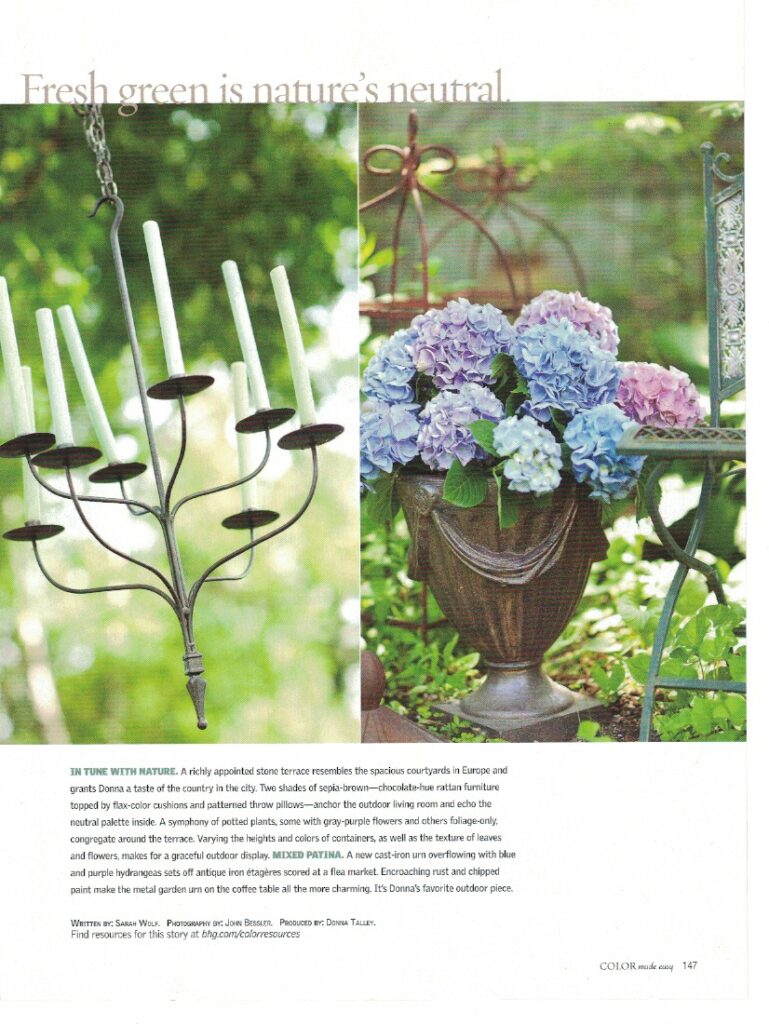
10. WATER FEATURE
A garden is more than just plants. It’s about emotion and how it feels to be in the space. And there’s nothing more soothing than the sound of water.
My friend Daniel Keeley’s garden in Fayetteville, Arkansas (shown below) features a gorgeous modern fountain as its centerpiece. Daniel is a noted Exterior Designer and owner of DK Design Outdoor and his work is inspirational. You can read more of my interview with Daniel in my “Design Friends” post.
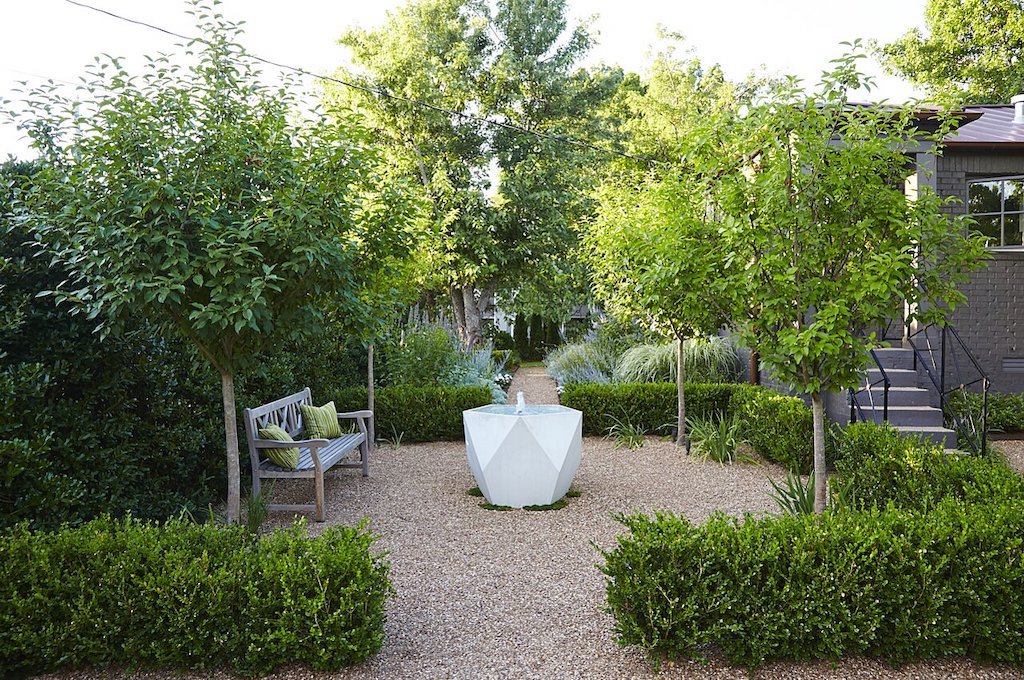
There are two strategies for placing a water feature in the garden. The first is to make it a central focal point, as Daniel did, set on a bed of pea gravel surrounded by lush perennial plantings. The second strategy is to tuck a fountain in a corner, where it serves as a quiet visual element. In my current garden, I placed a two-tiered fountain in the corner of a green hedge of spruce trees, with ‘Goodwin’s Creek’ lavender at its feet (below left). You can also add a simple wall fountain, which I did in the small courtyard of my former townhouse in Dallas (below right).
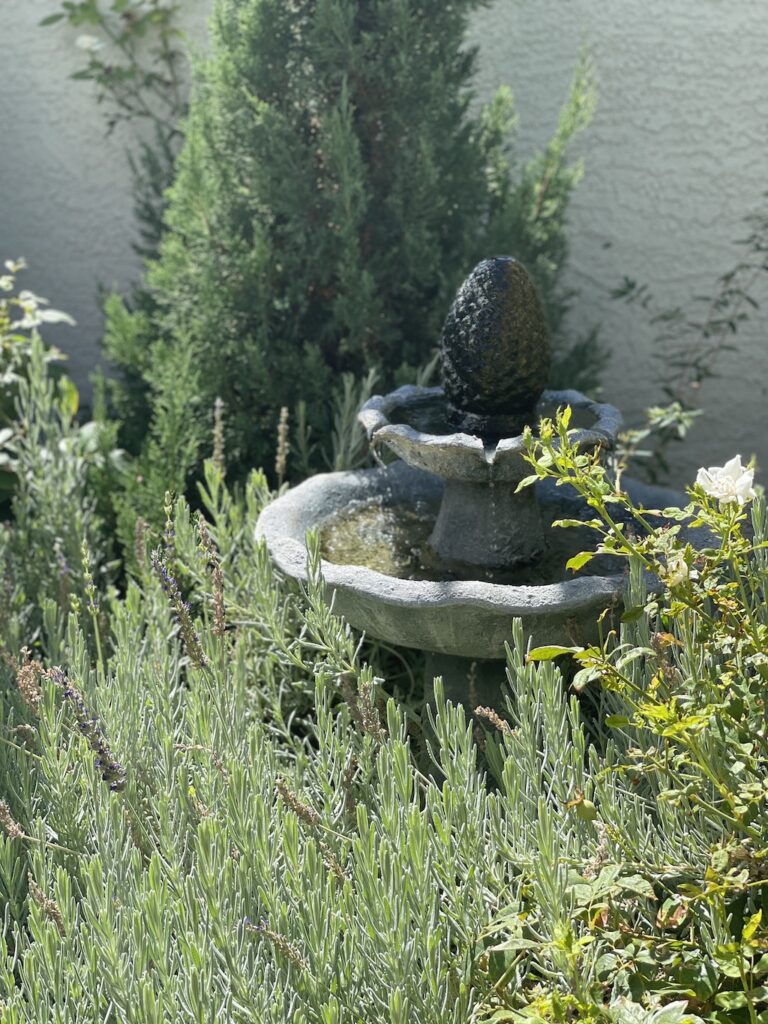
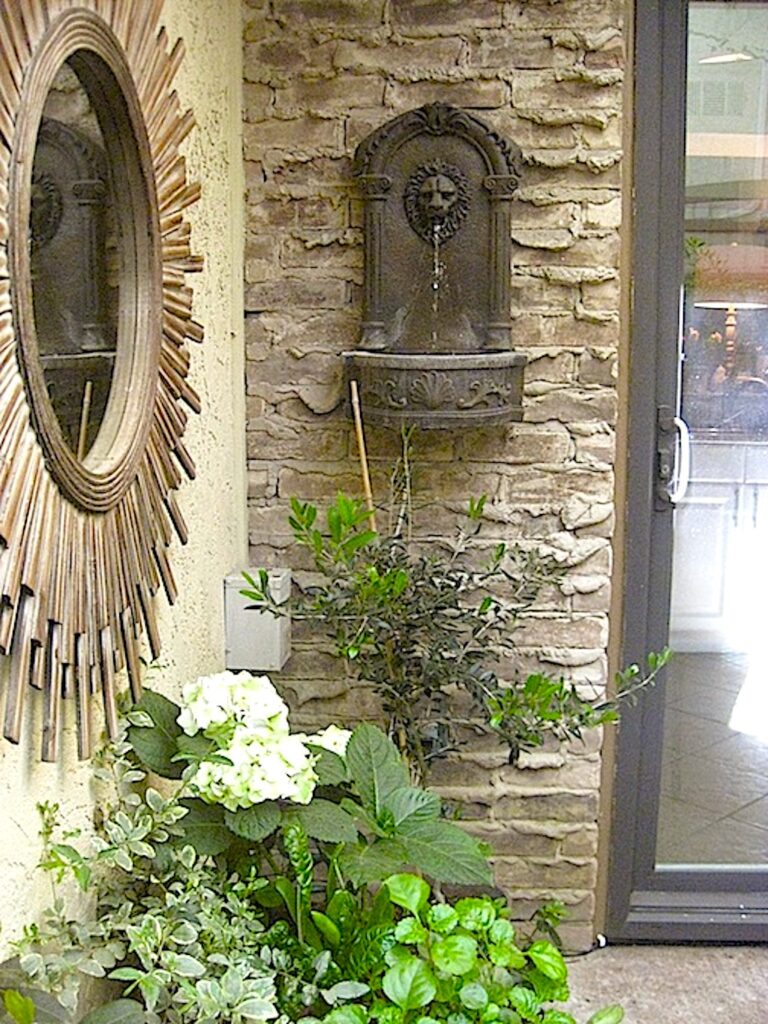
SHOPPING FOR THE GARDEN
I’ve compiled a shopping gallery for some of my favorite items for the garden below. Click on the images and it will take you to the shopping link to purchase.
